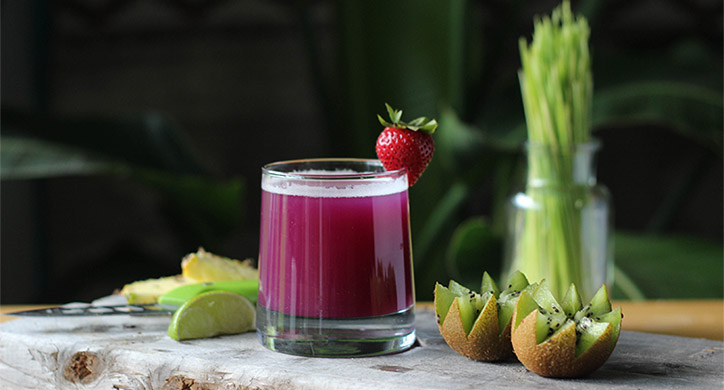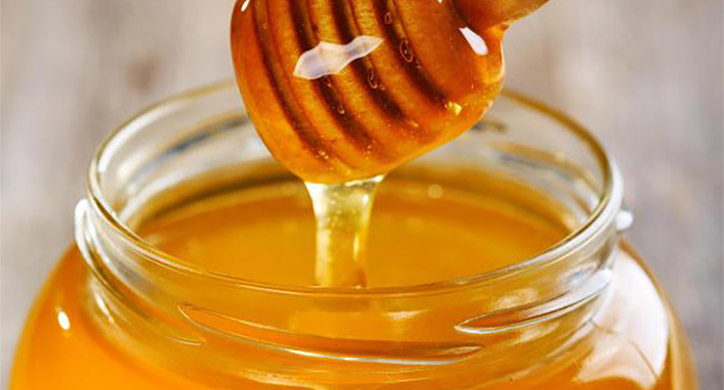The Dirt-to-Dinner team loves honey— a few of us even keep hives in our backyard. We put honey in tea, on yogurt, and even use it to sweeten some homemade desserts. So we got to thinking, should we all be replacing sugar with honey? Yes!for two reasons:
- Honey is more easily digested than sugar. The way our bodies digest honey is different because the bee enzymes in the nectar divide the sucrose into two simple sugars, fructose, and glucose, so the bees have already done the hard work for us!
- Honey contains trace amounts of nutrients, whereas sugar contains none.

Honey contains vitamins, minerals and amino acids that sugar does not.
Fresh honey is comprised of about 200 different compounds, including water, glucose, fructose; other sugars such as sucrose, maltose and galactose; vitamins, minerals, amino acids and proteins, and even bio-active compounds and antioxidants, which are known to promote good health. These compounds include phenolic acid, flavonoids, α-tocopherol, proteins, carotenoids, and certain enzymes, such as glucose oxidase and catalase.
While honey does contain these beneficial elements, the values are quite low and should not be considered a source of nutrients. You wouldn’t want to just eat honey to meet your daily calcium requirement as you would need about 49 cups a day to do that!
Bees are the only insects in the world that make food humans can eat!
How do bees make honey?
All honey begins as nectar, which is produced in plants to attract pollinators like bees and butterflies. Nectar is basically a sugar solution of sucrose (glucose and fructose)and is naturally about 80% water. Nectar also contains amino acids and proteins, and other nutritional compounds.

Honey bee gathering nectar from a blackberry blossom. The honey bee is not only extremely adept at pollination, but they also are the most prolific producers of honey. Image: Rusty Burlew, Honeybee Suite
A small amount of glucose is converted into gluconic acid and hydrogen peroxide. Gluconic acid makes honey acidic, and hydrogen peroxide has germ-killing properties, both of which contribute to honey’s unique therapeutic qualities.
Bees use their proboscis (straw-like tongues) to draw in the nectar and begin the process of digestion. Through the use of enzymes and dehydration, the water content of nectar gets reduced and two enzymes, invertase, and glucose oxidase break down the complex sugar (sucrose) into more simple sugars (glucose and fructose). Because of the enzymes, honey sugars are more easily digested than other sugars such as cane sugar.
It is believed that honey’s beneficial properties are due to both its nutrient composition, as well as it’s high sugar content, low acidity, the presence of hydrogen peroxide, and low moisture content.

Bees at work! Image: Dirt-to-Dinner

Capped honey – ready to be eaten! Image: Dirt-to-Dinner
Is homegrown honey safe?
You may have received a gift of honey from a friend or purchased local honey from a farmer’s market and are questioning the safety of honey that comes directly from the hive.
Honey is a safe, pure and nearly sterile product from the hive. Keeping it that way is the first consideration of honey producers. Sterile equipment, humidity levels, moisture content, and properly-sealed containers are all top considerations. If honey maintains the same water content as in the hive (18%) and is continuously stored in a sealed container, it is perfectly safe to eat for all but those under 1 year old. Infants do not have the immune system to handle the very trace botulism spores that may be present in honey.
“Honey in its natural form is very low moisture. Very few bacteria or microorganisms can survive in an environment like that, they just die. They’re smothered by it, essentially.”
… As long as the lid stays on it and no water is added to it, honey will not go bad…. If you leave a jar opened, it may get more water in it and it may go bad.” (Amina Harris, Executive director, Honey and Pollination Center, Robert Mondavi Institute at University of California. Excerpted from Smithsonian Magazine)
When in doubt, ask your gift-giver or farmer about how they extract and bottle their honey. They are stalwart friends of the environment and protectors of the food supply, and will love to talk to you about their honey and bees!
What is “supermarket” honey?

American’s appetite for honey far exceeds what we can produce, so the majority of honey sold today is imported from Vietnam, Argentina, India, Brazil, and Ukraine.
This imported product is quite different from what is produced by your local apiary. Studies have shown that heating honey at high temperatures has a negative effect on enzymes, color, flavor, and aroma. Supermarket honey is heated to remove and filter the comb and hive residue, which appeals to consumer demands for a clean, clear liquid, but bears no resemblance to the quality of fresh honey. To maximize the health benefits available in honey, it should be consumed raw or very minimally processed, without the use of heat.
Raw, filtered or organic? Honey labeling regulations
While there are guidelines in place for honey labeling, many producers will over-label to attract customers.
- Labeling of honey is guided by the FDA, and only pure honey can be labeled “Honey.” If it is not pure honey, then the label must indicate so. For instance, “honey with raspberry flavoring.”
- There is no regulatory definition of raw honey. The National Honey Board defines raw honey as “honey as it exists in the beehive or as obtained by extraction, settling or straining without adding heat.”
- There is a voluntary grading system for honey, but don’t be fooled. “Grade A Fancy” must be “free of defects that affect the appearance and may not contain particles that affect clarity.” But this could pertain to clear honey that has been heated and filtered which would have removed all the beneficial components of honey.
- There is no such thing as non-GMO honey. Contrary to what food marketers may lead you to believe, there’s no GMO counterpart for honey so don’t fall for the misinformation.
- Organic honey is beyond the ability of most US beekeepers.
Our chat with a beekeeper…
Charles Mraz, a producer of raw and liquid honey from Champlain Valley Apiaries, discussed the complexities of labeling with the Dirt-to-Dinner team.
“Differentiating our pure honey products is a challenge in the face of those who take advantage of consumers with false labeling. For example, pure honey is by definition, a non-GMO food, but some producers will add that label. Consumers don’t know the real facts about honey and may reach for the non-GMO product.”
Mraz continues, “Consumers should beware of honey labeled organic. Producers who make over $5,000 a year on honey sales are held to strict USDA organic label requirements, which cover every piece of equipment and product used in beekeeping. This makes the production of organic honey nearly impossible for most American beekeepers. For example, bees will forage an average of 2 miles – but sometimes up to 5 miles – from their hives in search of pollen and nectar. A hive would have to be located in the center of at least 16 square miles of organic plants to qualify for organic status. And that land cannot be near a golf course, power line, or any land where herbicides are used, including residential neighborhoods.”
FUN FACTS ABOUT HONEY BEES
There are 3 types of honeybees: the worker, the drone and the queen. Each has a very specific role to play in the hive, and they depend on each other for survival.
In order to produce 1 pound of honey, 2 million flowers must be visited.
A hive of bees must fly 55,000 miles to produce a pound of honey. An average worker bee makes only about 1/12 teaspoon of honey in its lifetime.
Source: https://www.honey.com/newsroom/presskit/honey-trivia
In most cases, honey bearing the USDA organic seal is produced in Brazil, Canada, Mexico or other nations that have organic standards, and the USDA honors the foreign organic programs and organic certification companies, even if their program is not close to USDA organic standards. This creates a dilemma for honey producers in the U.S. who want to sell their products, and creates confusion in the grocery store!
So how do you know what you are getting? Buy local or know your apiary. Champlain Valley, for instance, has an online store for their raw honey and other honey products – and their honey is delicious! You can also find local honey by searching on the National Honey Board.

















